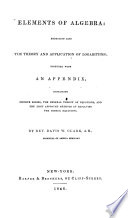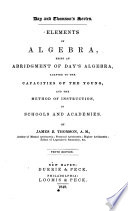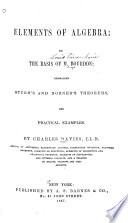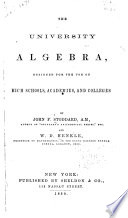 | James Bates Thomson - Algebra - 1844 - 266 pages
...first term. 257. From this principle is derived the following METHOD FOR COMPLETING THE SQUARE. Take the square of half the co-efficient of the first power of the unknown quantity, and add it to both sides of the equation. 258. It will be observed that there is nothing peculiar in... | |
 | Davis Wasgatt Clark - 1844 - 394 pages
...first, second, third, or fourth power, the first member may be rendered a perfect square by adding the square of half the coefficient of the first power of the unknown quantity to both members of the equation. This is called completing the square. 326. Each of the above equations... | |
 | Davis Wasgatt Clark - Algebra - 1846 - 374 pages
...first, second, third, or fourth power, the first member may be rendered a perfect square by adding the square of half the coefficient of the first power of the unknown quantity to both members of the equation. This is called completing the square. 326. Each of the above equations... | |
 | Jeremiah Day, James Bates Thomson - Algebra - 1848 - 264 pages
...first term. 257. From this principle is derived the following METHOD FOR COMPLETING THE SQUARE. Take the square of half the co-efficient of the first power of the unknown quantity, and add it to both sides of the equation. 258. It will be observed that there is nothing peculiar in... | |
 | Joseph Ray - Algebra - 1848 - 250 pages
...impossible. See Art. 195. Therefore, in the third and fourth forms, when q is greater than p2, that is, when the known term is negative, and greater than the square of half the coefficient of the first power of x, both values of the unknown quantity are impossible. What is the cause of this impossibility ? To... | |
 | Joseph Ray - Algebra - 1852 - 408 pages
...negative quantity, which is impossible (Art. 193). Hence, when q is greater than p-, that is, when the known term is negative, and greater than the square of half the coefficient of the first power of x, Ote roots are imaginary. To show why the roots are imaginary, we must inquire, into what two parts... | |
 | Education - 1852 - 844 pages
...rule for completing the square after arranging the terms, is to add to both members of the equation the square of half the coefficient of the first power of the unknown quantity. Bonnycastle, Day, and others, add the following rule for particular cases : Multiply the equation into... | |
 | Charles Davies - Algebra - 1857 - 408 pages
...becomes equal to p2. Hence, 3d. The greatest possible value of the product of the two roots, is equal to the square of half the co-efficient of the first power of the unknown quantity. • Of the Four Forms. 117i Thus far, we have regarded p and q as algebraic quantities, without considering... | |
 | Jeremiah Day - Algebra - 1859 - 192 pages
...first power of the unknown quantity, add and subtract the square root of the known term increased by the square of half the coefficient of the first power of the unknown quantity, and the results will be the two values of x. In many of the following solutions the processes of completing... | |
 | John Fair Stoddard, William Downs Henkle - Algebra - 1859 - 538 pages
...taken with a contrary sign, plus or minus the square root of the known term after it has been added to the square of half the coefficient of the first power of the unknown quantity. REMARK. — The student should apply this rule in the solution of the following examples after they... | |
| |